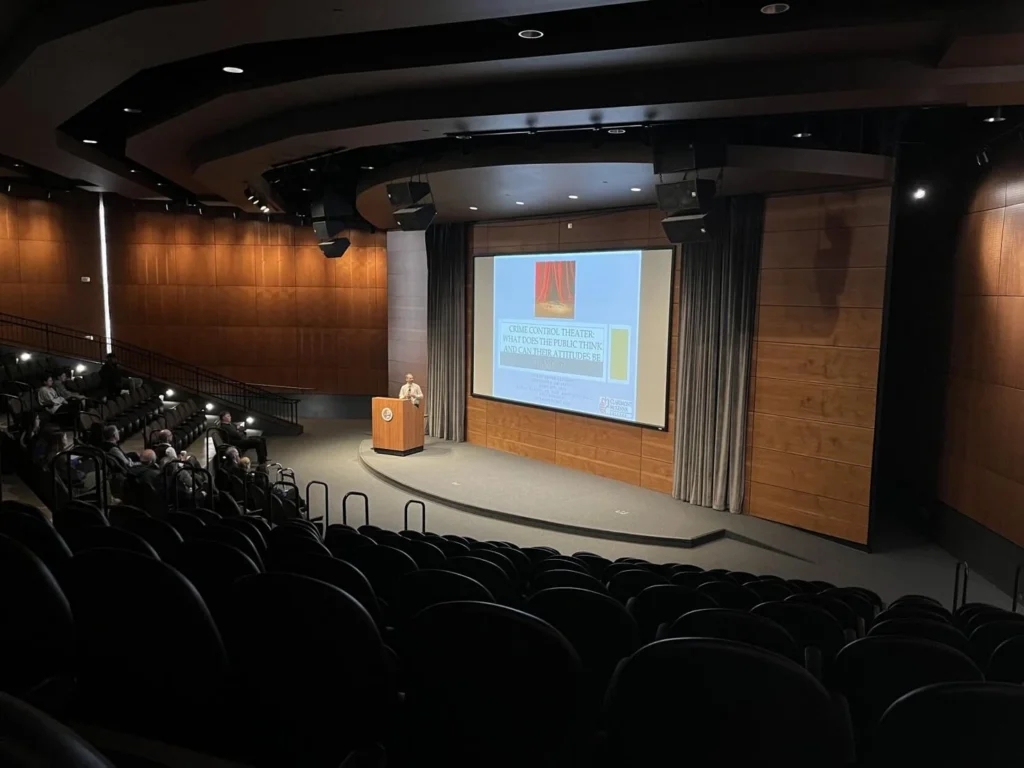
Last Thursday, Creighton University hosted Professor Daniel Krauss, J.D., Ph.D., from Claremont McKenna College in the Harper Auditorium. At the event titled “Crime Control Theater: What Does the Public Think and Can Their Attitudes Be Changed,” Krauss discussed various crime control laws and their effects on society.
Krauss focuses on forensic psychology and is fundamentally fascinated by the “disconnects” in modern society. He said “the law makes lots of assumptions about human behavior,” and referenced eyewitness accounts as being inaccurate at times, despite the justice system’s trust in their accuracy.
He defined “crime control theater” by referencing other research conducted by Timothy Griffin and Monica K. Miller in 2008. In their study, they refer to crime control theater as “a socially constructed ‘solution’ to a socially constructed problem.”
Essentially, crime control theater refers to the illusion of reducing crime but not actually fixing the problem. Crime control theater is rooted in four elements: it is created in moral panic, has unquestioned acceptance and promotion, is based up on mythic narratives and has unanticipated consequences.
Some examples of “crime control theater” include AMBER Alerts, sex offender registration and notification laws, sex offender housing restriction laws, safe-haven laws and three-strike laws. In his talk, Krauss focused on sex offender registration and notification laws as well as sex offender housing restriction laws.
When speaking of sex offender registration and notification laws, Krauss referenced the kidnapping and murder of Megan Kanka in 1994 and the moral panic that stemmed from her case. In this case, the two-time convicted sex offender, Jesse Timmendequas, lived next door to Megan Kanka, who he killed. The parents of Megan then sponsored a bill to require the knowledge of a sex offender living in a neighborhood.
Laws like the 1994 Jacob Wetterling Act, the 1996 Megan’s Law and the 2006 Adam Walsh Protection and Safety Act, all focus on having sex offender information available to the public.
Kraus discussed how, while this may seem like a good idea in theory, many violent sex offenders attack children they know. From this mythic narrative, there are empirical failures and consequences. The laws further isolate offenders, which makes it difficult for them to be active members of society.
Kraus then discussed the experiments he has conducted on the support of crime control theater laws and their effectiveness while comparing them to non-crime control theater laws. From his experiments, he found that “crime control theater” laws often have a higher support and higher predicted effectiveness than non-crime control theater laws.
Another point Kraus discussed is how AMBER Alerts are a classic example of crime control theater. They almost are never used to capture a stranger abduction, while the intention of their creation was to prevent stranger abductions. AMBER Alerts are more commonly used for child custody issues.
College of Arts and Sciences freshman Fiona Dobie shared that she was surprised by Kraus’s comments about AMBER Alerts.
“I thought it was interesting how he was talking about the AMBER Alerts and how they are for domestic cases and less from kidnapping from strangers. I hear a lot about AMBER Alerts, but they’re all domestic,” Dobie said.
The event gave Dobie and other students the chance to learn something new and widen their perspective regarding crime control laws.